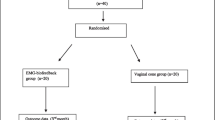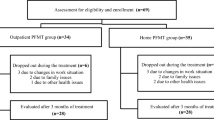Abstract
Introduction and hypothesis
Extracorporeal biofeedback was developed to reduce patient discomfort when performing strengthening exercises. The efficacy and safety of extracorporeal biofeedback combined with pelvic floor muscle training (PFMT) for the treatment of female stress urinary incontinence (SUI) were evaluated.
Methods
One hundred and six participants with SUI were enrolled in a 12-week PFMT program using extracorporeal biofeedback intervention. A standard pad test was performed, and pelvic floor muscle strength was assessed using the Oxford scale. Measurements were taken with a perineometer at baseline and at a 12-week follow-up visit. An objective cure was defined as less than 2 g of urine leakage by the standard pad test. The long-term effects of extracorporeal biofeedback and PFMT were investigated by interviewing the participants 12 months after treatment.
Results
Seventy-one participants completed the 12-week extracorporeal biofeedback intervention. The objective cure rate was 52.1 %, and there was a significant reduction in pad weight over the time period. The incontinence visual analogue scale, the Sandvik severity index, and the incontinence quality-of-life questionnaire domains were significantly improved after treatment (p < 0.001). The strength of the PFM was significantly increased after the 12-week treatment. After PFMT, 64.3 % of 56 participants reported good treatment compliance, and 24 participants (42.9 %) had continued PFMT at home 12 months after treatment. Age and baseline pad weight were negative predictive factors for an objective cure of SUI.
Conclusions
Pelvic floor muscle training using extracorporeal biofeedback can be an effective and safe conservative treatment option for female SUI without the discomfort caused by vaginal sensors.



Similar content being viewed by others
References
Kegel AH (1948) Progressive resistance exercise in the functional restoration of the perineal muscles. Am J Obstet Gynecol 56:238–248
Burgio KL (1994) Behavioral therapy: practical approach to urinary incontinence. Contemp Urol 6:24, 29–36, 41
Gormley EA (2002) Biofeedback and behavioral therapy for the management of female urinary incontinence. Urol Clin N Am 29:551–557
Burgio KL, Robinson JC, Engel BT (1986) The role of biofeedback in Kegel exercise training for stress urinary incontinence. Am J Obstet Gynecol 154:58–64
Burns PA, Pranikoff K, Nochajski TH, Hadley EC, Levy KJ, Ory MG (1993) A comparison of effectiveness of biofeedback and pelvic muscle exercise treatment of stress incontinence in older community-dwelling women. J Gerontol 48:M167–M174
Bo K, Talseth T, Holme I (1999) Single blind, randomised controlled trial of pelvic floor exercises, electrical stimulation, vaginal cones, and no treatment in management of genuine stress incontinence in women. BMJ 318:487–493
Yun JM, Kim SJ, Lee KS (2000) The effect of pelvic floor muscle training with biofeedback and functional electrical stimulation for genuine stress urinary incontinence. Korean J Urol 41:627–632
Morkved S, Bo K (2000) Effect of postpartum pelvic floor muscle training in prevention and treatment of urinary incontinence: a one-year follow up. BJOG 107:1022–1028
Benvenuti F, Caputo GM, Bandinelli S, Mayer F, Biagini C, Sommavilla A (1987) Reeducative treatment of female genuine stress incontinence. Am J Phys Med 66:155–168
Ferguson KL, McKey PL, Bishop KR, Kloen P, Verheul JB, Dougherty MC (1990) Stress urinary incontinence: effect of pelvic muscle exercise. Obstet Gynecol 75:671–675
Kondo A, Yamada Y, Niijima R (1995) Treatment of stress incontinence by vaginal cones: short- and long-term results and predictive parameters. Br J Urol 76:464–466
Dwyer NT, Kreder KJ (2005) Conservative strategies for the treatment of stress urinary incontinence. Curr Urol Rep 6:371–375
Aukee P, Immonen P, Laaksonen DE, Laippala P, Penttinen J, Airaksinen O (2004) The effect of home biofeedback training on stress incontinence. Acta Obstet Gynecol Scand 83:973–977
Brink CA, Wells TJ, Sampselle CM, Taillie ER, Mayer R (1994) A digital test for pelvic muscle strength in women with urinary incontinence. Nurs Res 43:352–356
Wu W, Sheu B, Lin H (2006) Comparison of 20-minute pad test versus 1-hour pad test in women with stress urinary incontinence. Urology 68:764–768
Isherwood PJ, Rane A (2000) Comparative assessment of pelvic floor strength using a perineometer and digital examination. BJOG 107:1007–1011
Kegel AH (1948) The nonsurgical treatment of genital relaxation; use of the perineometer as an aid in restoring anatomic and functional structure. Ann West Med Surg 2:213–216
Sandvik H, Seim A, Vanvik A, Hunskaar S (2000) A severity index for epidemiological surveys of female urinary incontinence: comparison with 48-hour pad-weighing tests. Neurourol Urodyn 19:137–145
Stamey TA (1980) Endoscopic suspension of the vesical neck for urinary incontinence in females. Report on 203 consecutive patients. Ann Surg 192:465–471
Haylen BT, de Ridder D, Freeman RM, Swift SE, Berghmans B, Lee J et al (2010) An International Urogynecological Association (IUGA)/International Continence Society (ICS) joint report on the terminology for female pelvic floor dysfunction. Int Urogynecol J Pelvic Floor Dysfunct 21:5–26
Berghmans LC, Hendriks HJ, Bo K, Hay-Smith EJ, de Bie RA, van Waalwijk van Doorn ES (1998) Conservative treatment of stress urinary incontinence in women: a systematic review of randomized clinical trials. Br J Urol 82:181–191
Hay-Smith EJ, Bo Berghmans LC, Hendriks HJ, de Bie RA, van Waalwijk van Doorn ES (2001) Pelvic floor muscle training for urinary incontinence in women. Cochrane Database Syst Rev: CD001407
Pages IH, Jahr S, Schaufele MK, Conradi E (2001) Comparative analysis of biofeedback and physical therapy for treatment of urinary stress incontinence in women. Am J Phys Med Rehabil 80:494–502
Hirsch A, Weirauch G, Steimer B, Bihler K, Peschers U, Bergauer F et al (1999) Treatment of female urinary incontinence with EMG-controlled biofeedback home training. Int Urogynecol J Pelvic Floor Dysfunct 10:7–10
Morkved S, Bo K, Fjortoft T (2002) Effect of adding biofeedback to pelvic floor muscle training to treat urodynamic stress incontinence. Obstet Gynecol 100:730–739
Jundt K, Peschers UM, Dimpfl T (2002) Long-term efficacy of pelvic floor re-education with EMG-controlled biofeedback. Eur J Obstet Gynecol Reprod Biol 105:181–185
Dumoulin C, Gravel D, Bourbonnais D, Lemieux MC, Morin M (2004) Reliability of dynamometric measurements of the pelvic floor musculature. Neurourol Urodyn 23:134–142
Bo K, Raastad R, Finckenhagen HB (2005) Does the size of the vaginal probe affect measurement of pelvic floor muscle strength? Acta Obstet Gynecol Scand 84:129–133
Bump RC, Hurt WG, Fantl JA, Wyman JF (1991) Assessment of Kegel pelvic muscle exercise performance after brief verbal instruction. Am J Obstet Gynecol 165:322–327
Liao YM, Dougherty MC, Liou YS, Tseng IJ (2006) Pelvic floor muscle training effect on urinary incontinence knowledge, attitudes, and severity: an experimental study. Int J Nurs Stud 43:29–37
Bo K, Hagen RH, Kvarstein B, Jorgensen J, Larsen S (1990) Pelvic floor muscle exercise for the treatment of female stress urinary incontinence: III. Effect of two different degrees of pelvic floor muscle exercises. Neurourol Urodyn 9:489–502
Wilson PD, Herbison GP (1998) A randomized controlled trial of pelvic floor muscle exercises to treat postnatal urinary incontinence. Int Urogynecol J Pelvic Floor Dysfunct 9:257–264
Burgio KL, Goode PS, Locher JL, Richter HE, Roth DL, Wright KC et al (2003) Predictors of outcome in the behavioral treatment of urinary incontinence in women. Obstet Gynecol 102:940–947
Acknowledgements
This study was supported by a grant of the Korea Healthcare Technology Research and Development Project, Ministry of Health and Welfare, Republic of Korea (A084152).
Conflicts of interest
None.
Author information
Authors and Affiliations
Corresponding author
Rights and permissions
About this article
Cite this article
Lee, H.N., Lee, S.Y., Lee, YS. et al. Pelvic floor muscle training using an extracorporeal biofeedback device for female stress urinary incontinence. Int Urogynecol J 24, 831–838 (2013). https://doi.org/10.1007/s00192-012-1943-4
Received:
Accepted:
Published:
Issue Date:
DOI: https://doi.org/10.1007/s00192-012-1943-4




